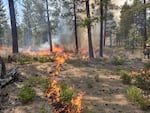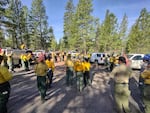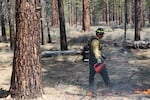
Forty firefighting professionals participated in a training program to gain hands-on experience with prescribed fires which were ignited in the Deschutes National Forest. The fires burned pine needles, dry grasses and shrubs in the forest understory over the course of five days in late April and May 2023.
Thomas Stokely/The Nature Conservancy
Forty firefighting professionals from the U.S. and Canada gathered recently in the Deschutes National Forest in Central Oregon to gain hands-on experience with prescribed fires.
Such fires help reduce fuel load, improve forest health and protect communities from wildfires which have grown more intense due to climate change and 100 years of suppressing fires.
Since its launch 15 years ago by the U.S. Forest Service, the Department of the Interior and The Nature Conservancy, the Prescribed Fire Training Exchange Program, or TREX, has taken place in more than a dozen states and has grown to include the involvement of Tribal nations, state and local governments, private landowners and other partners.

Forty certified firefighting professionals took part in a training program to gain hands-on experience with igniting prescribed fires. The two week-long training took place in the Deschutes National Forest and ended on May 5, 2023.
Thomas Stokely/The Nature Conservancy
Thomas Stokely, a forest ecologist with The Nature Conservancy in Central Oregon, was one of the lead coordinators of the two week-long training session which ended Friday.
According to Stokely, prescribed burns can help forested lands resemble a landscape that existed before a policy of aggressive fire suppression by the U.S. Forest Service led to a buildup of dense vegetation which provides fuel for wildfires to spread so quickly and catastrophically today.
“In the ponderosa pine system where we’re at right now, those systems burned naturally or due to human ignitions from a cultural burning by Indigenous communities every 10 to 20 years,” he said. “So that fire would have helped to maintain more open stands with large old growth trees that are adapted to fire and can withstand those low intensity surface fires.”
Kaci Radcliffe, the Northeastern Oregon forest restoration project manager for The Nature Conservancy, said she wanted to participate in the TREX training for both professional and personal reasons.
“Both of my families in Washington and Alaska have had wildfires that have threatened their homes,” she said. “Fire is becoming more frequent, and so I wanted to know how I could help, how could I help them reduce their risk … and this is a really good place to get started.”
Although Radcliffe doesn’t have a background in firefighting, she still had to obtain a Firefighter Type 2 level of certification before she could participate as an active crew member, learning the various roles and tools required to manage a prescribed burn, from planning it to digging a handline to contain the flames and readying water pumps to douse stray embers.
“I had never used these specialized tools like a Pulaski which has what they call a grubbing end that helps you dig through the duff to get to soil, and an ax end,” Radcliffe said.

Participants in The Prescribed Fire Exchange Training Program, or TREX, that took place in the Deschutes National Forest learned how to use tools such as a drip torch which is used to ignite fires, and the various responsibilities that are key to safely and effectively conducting prescribed fires. The two week-long TREX training in Central Oregon ended on May 5, 2023.
Jodie Barram
But on a more basic level, the training helped Radcliffe sharpen her fluency in talking about fire, which was critical to do when working with dozens of people who came from different backgrounds, regions and countries.
“There’s a lot of language and terminology that’s specific to fire and that’s really important so when you’re out there, everyone agrees on what terms mean,” Radcliffe said. “It was actually kind of fun to do some matching to say, ‘hey, do you call this the same thing as I do, or when I give you this direction, do you really clearly understand what I’m asking you to do?’”
In Central Oregon, prescribed burns typically take place over a span of roughly three weeks in the spring and fall. Stokely said the trainees “got really lucky” with favorable weather conditions that allowed for 1,000 acres in the national forest to be burned over the course of five days. Still, the work was arduous, with 16-hour days of carrying heavy backpacks and equipment through stands of ponderosa pines and bitterbrush.
“(I) actively got to work on about 500 of those acres across a half dozen locations, and my pedometer says that I’ve walked over 50 miles,” Radcliffe said.
The prescribed burns took place near the communities of Sisters and La Pine. The flames and billowing smoke provided residents living nearby a chance to view up close a fire management tool that can help protect their homes and livelihoods.
“A lot of folks would ride their bikes, or were jogging by and were cheering us on and very thankful for the work we were doing because those people that live in those communities really understand the threats that are facing those cities,” Stokely said.
And the more visible the prescribed burns are, the greater the opportunity to build community support for adapting to a new relationship with fire: one that is proactive instead of reactive, embraced instead of suppressed.
“There’s an increasing need to keep with the messaging and to keep providing the public more information about why we’re doing this burning so that we can get more public support because that’s a major limiting factor - that sort of social license to be doing these restoration activities in the forest,” Stokely said.
Thomas Stokely and Kaci Radcliffe spoke to “Think Out Loud” host Dave Miller. Click play to listen to the full conversation:
